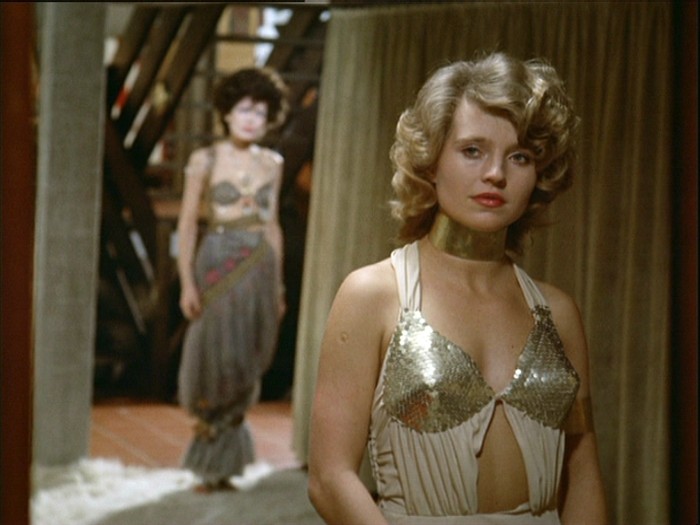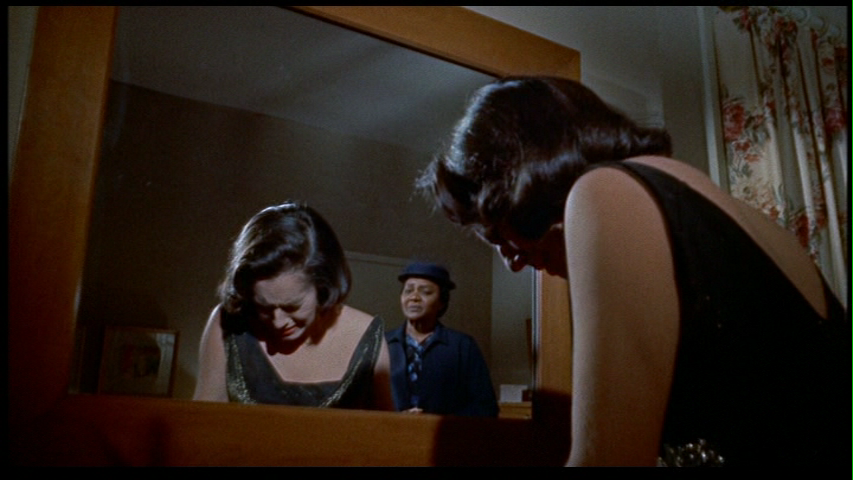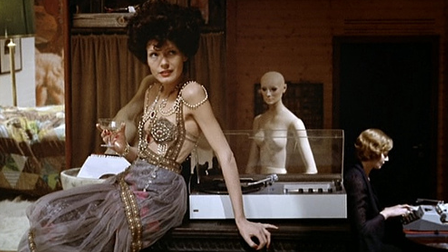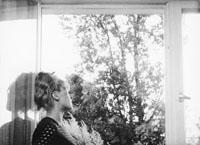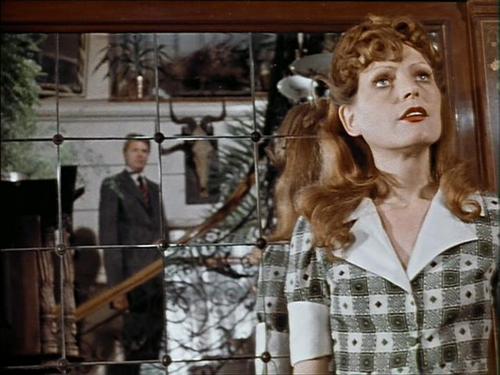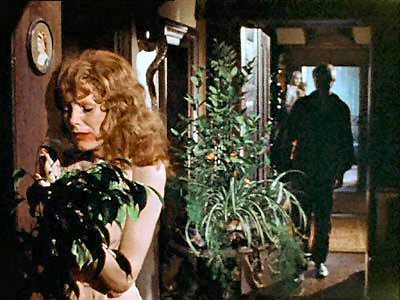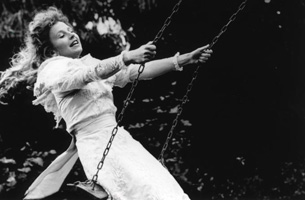From the Chicago Reader (May 2, 1997). — J.R.
Films by Rainer Werner Fassbinder
I’m still trying to figure out what I think of Rainer Werner Fassbinder (1945-1982), the German whiz kid who’s the focus of a nearly complete retrospective showing at the Film Center, Facets Multimedia Center, and the Fine Arts over the next couple of months. An awesomely prolific filmmaker (he turned out seven features in 1970 alone), Fassbinder became the height of Euro-American fashion during the mid-70s, then went into nearly total eclipse after his death from a drug overdose — reminding us that the fate of a fashionable filmmaker is often to be discarded (as, more recently, have been David Lynch and Quentin Tarantino).
As skeptical as I often was in the 70s about Fassbinder as a role model, I’ve been more than a little disconcerted by the speed with which he’s vanished from mainstream consciousness. Having now seen two dozen of his 37 features, one of his four short films, and one of his four TV series — though I haven’t seen many of them since they came out — I find much of his work, for all its deliberate topicality, as fresh now as when it first appeared.
In some ways it may be even fresher, because its meanings are no longer ruled by the same political agendas. Part of my reluctance to join the Fassbinder bandwagon in the 70s was that I couldn’t accept without qualms the critical industry’s interpretation of his work as left-wing and subversive — an interpretation that was intricately bound up with the rediscovery of Douglas Sirk’s 50s Hollywood movies by Fassbinder and others. For academics who argued — and in many cases still argue — that Sirk soap operas like Imitation of Life were subversive critiques of American life rather than conformist endorsements, a historical sleight of hand was necessary, particularly when it came to dealing with the reception those movies were given back in the 50s. Sirk — who was a leftist stage director in pre-Nazi and Nazi Germany and a closet intellectual and campy commercial director in both Germany and the U.S — made movies with conservative and conformist as well as skeptical and subversive elements. The conservative and conformist elements played most indelibly to his producers and his contemporary audiences; the skeptical and subversive ingredients were cynically, carefully buried, waiting to be discovered by future generations.
Reconciling Sirk’s or Fassbinder’s cynicism with a leftist political agenda has always struck me as problematic. Both directors tended to deal with characters incapable of understanding their own social victimization and, more often than not, incapable of change; regarding these doomed characters with ironic compassion, Sirk and Fassbinder were arguably more defeatist than progressive, because their sophistication consisted chiefly of recognizing corruption and stupidity, not of imagining situations where they might be overcome. The worlds both directors conjured up resemble more stylish versions of the repressed world found in W.C. Fields comedies– bounded on all sides by irritations and petty frustrations. (“There are no lighthearted moments in any Fassbinder film that I can recall,” Gary Indiana wrote in Artforum last February. “If a character’s happy, it’s because he hasn’t yet heard the bad news.”) Fassbinder differed most strikingly from Sirk in focusing much more often on working-class and petit bourgeois characters, at least through the mid-70s, but the sense of entrapment was no less pronounced.
Sirk’s stylistic hallmarks included theatrical uses of lighting, color, and mirrors, and his thematic hallmarks included blindness; in the most general terms, one could say his movies were all about ways of seeing and not seeing. Fassbinder’s self-conscious and low-budget appropriation of these hallmarks made them at once more overt and more overtly campy, so that contemporary readings of Fassbinder films were fully in tune with these attitudes in a way that contemporary readings of Sirk films were not. I’ll never forget a late-70s lecture on Sirk’s All That Heaven Allows and Fassbinder’s Ali: Fear Eats the Soul given at the University of California-San Diego by Jean-Pierre Gorin, a former collaborator of Godard’s (and a closet intellectual in a southern California setting, much as Sirk was). Like a Mystery Science Theater 3000 kibitzer, Gorin offered plenty of irreverent and often hilarious wisecracks about the Sirk film while it was playing, but he didn’t dare submit Ali to the same jaundiced treatment. (People who make fun of old movies nearly always have the self-serving presumption that folks back then were naive and corny, not sophisticated as they are today.)
Openly bisexual, tyrannical on his sets, and habitually dressed in a leather jacket, Fassbinder cut a starlike figure in the firmament of New German Cinema, though in this respect he was hardly alone. If the French New Wave of the 60s was mainly about films, the New German Cinema of the 70s was mainly about filmmakers, and each of the best-known directors had a claim to fame that was mainly a matter of public image: eccentric exhibitionism crossed with German romanticism (Werner Herzog), existentialist hip crossed with black attire and rock ‘n’ roll (Wim Wenders), Wagnerian pronouncements (Hans-Jürgen Syberberg), a dandy’s stupefied worship of shrines and divas (Werner Schroeter), and so on. When it came to Fassbinder, who improbably evoked both John Belushi and Andy Warhol, one was made to feel that the real drama in film after film wasn’t in the makeshift characters or the fruity images but in the offscreen intrigues of a baby Caligula manipulating his players and technicians.
These intrigues were directly or obliquely referred to in successive features — most explicitly in Beware of a Holy Whore (based on the shooting of Whity in Spain five months earlier, with Lou Castel in the Fassbinder role and Fassbinder playing someone else), but the sense of coded reference to the Fassbinder entourage and its complex inner life seemed nearly constant as long as the team stayed together. While writing and directing a good many plays (staged in seven separate German cities between 1969 and 1976) and a few radio plays as well as films, and acting in many of his productions, Fassbinder used his evolving repertory group the way a painter uses colors. This frenzy of activity culminated in his 14-part TV series Berlin Alexanderplatz (completed in 1980), based on the Alfred Döblin novel and to be screened at Facets starting May 30. Hanna Schygulla, Irm Hermann, Ulli Lommel, Ingrid Caven, Kurt Raab, and Harry Baer — all of whom appear in either or both of Fassbinder’s first two features (both 1969) — were part of this group for years, and they were eventually joined by Günther Kaufmann, Michael König, Margit Carstensen, Eva Mattes, Brigitte Mira, Karlheinz Böhm, and El Hedi ben Salem, among many others. (Some of them, like Raab and Baer, would double as crew members.)
After Berlin Alexanderplatz Fassbinder went in mainly for large-scale international coproductions that used more actors from outside his circle and more writers. His ambitions were larger, but the results were less homogeneous. (Perhaps the most sustained and interesting defense of the later films can be found in the writing of Thomas Elsaessar, a film academic based in Amsterdam, who sees most of them as part of a larger project to retell the history of Germany in the 20th century.)
Jean-Marie Straub and Daniele Huillet’s challenging, beautiful, and exciting The Bridegroom, the Comedienne, and the Pimp (1968) — only 23 minutes long, but by far the best and most important film Fassbinder ever acted in — is fortunately included in the retrospective, though it won’t turn up until June 22, in a program of shorts by Fassbinder and others (including his remarkable, corrosive self-portrait in the sketch film Germany in Autumn). It’s a work that provides many keys to understanding Fassbinder’s oeuvre — in particular the early features and Effi Briest.
A singular work made up of many seemingly disjointed segments but only 12 shots, The Bridegroom, the Comedienne, and the Pimp is the only one of Straub-Huillet’s 20 films to date not explicitly derived from specific literary, musical, or dramatic sources — though such sources are used, chiefly poetry by Saint John of the Cross, passages from Bach’s Ascension Oratorio, and a performance of Ferdinand Bruckner’s 1926 play Pains of Youth, which Straub reduced to only 11 minutes, recording it in a single take from a fixed camera (Fassbinder stars as a pimp; he turns up again at the very end of the film and is shot dead by the heroine). This version of the play was also performed live at Munich’s Action-Theater on a program with Fassbinder’s first play (the source of one of his best early features, Katzelmacher), and the radical concentration and organization of the Bruckner clearly had a lasting effect on Fassbinder’s work. When the Action-Theater was disbanded in May 1968 — reportedly after one of its founders, jealous of Fassbinder’s growing influence in the group, trashed the premises — it was immediately reformed under Fassbinder’s full control and renamed the Anti-Theater. By most accounts, including Fassbinder’s, his first nine features (up through Beware of a Holy Whore) were Anti-Theater productions — in much the same way that Orson Welles’s early stage and radio work and films were all Mercury productions.
“After seeing Douglas Sirk’s films I am more convinced than ever that love is the best, most insidious, most effective instrument of social repression,” Fassbinder wrote in 1971. The fact that he said “best” instead of “worst” is entirely characteristic of his ironic dramaturgy, which relishes the traps and suffering of his characters even as it implicitly lodges protests against them. Sadomasochistic impulses are at the heart of most of his films, and the tricky task of squaring those impulses with some kind of attack on sociopolitical oppression is what has often made it difficult for me to come to terms with his work. My favorite Fassbinder movie, Martha (1973), arguably faces these issues most directly, and because its Chicago premiere is being held this week (a single screening at the Fine Arts on May 7), it might serve as a convenient starting point. (The main reason for this film’s belated arrival is a long-term problem involving the rights to the Cornell Woolrich novel the plot is loosely based on.)
A virgin librarian in her 30s named Martha Hyer (Margit Carstensen) meets a bridge builder (Karlheinz Böhm) while vacationing in Rome, around the time her father dies, and she and the bridge builder wind up getting married back in Germany. It’s a match made in heaven — she’s a masochist, he’s a sadist — and Fassbinder recounts most of this horrific tale as if it were high comedy, though the delivery is poker-faced, and there’s a lot of ambiguity about how much of Martha’s terror is predicated on justifiable fear rather than paranoia (the surviving Woolrichian element). A parody of bourgeois marriage with fluid camera movements, balancing deep-focus effects, and vivid candy-box colors, it proceeds like a Hollywood nightmare in which the husband’s insane demands and accelerating cruelties and the wife’s belief that she deserves his behavior fit snugly into the banalities of soap opera. The content is hysterical, but the baroque visual style is so controlled that it’s hard to figure out which is more outrageous, the couple’s madness or the film’s treatment of it as normal and everyday. The irreconcilable tension between these registers produces a kind of spontaneous combustion in the viewer — a crisis in representation whose effects are political in the most potent way.
The year 1973 also yielded the two-part World on a Wire, Nora Helmer (a rewrite of Ibsen’s A Doll’s House in which the heroine — again played by Carstensen — doesn’t leave home at the end), Ali: Fear Eats the Soul (a tragic love story between a widowed cleaning lady and a Moroccan who’s 20 years younger), most of the shooting of Effi Briest (an ambitious and relatively cerebral black-and-white adaptation of Theodor Fontane’s 1894 novel, released in 1974), and Fox and His Friends (a fable about economic exploitation with Fassbinder as the exploited party and, apart from the lesbian chamber drama The Bitter Tears of Petra von Kant from 1972, probably the only Fassbinder film of this period centered on openly gay characters). I haven’t seen World on a Wire or Nora Helmer, but the last three of these features surely have to be counted among his finest works.
Yet even here there are moments that give me pause. Clever and nuanced in many of its details, even if it’s rather obvious and predictable in overall design, Fox and His Friends may look less fresh today than it did when it came out because depictions of gay milieus have become more commonplace in movies. (It also may look even less politically correct — something Fassbinder’s films never are.) The moment in it that I recall most vividly occurs in the first reel, a low-angle shot of Fox (Fassbinder) — a carnival sideshow performer who’s lost his job and his lover and has recently been picked up by an antiques dealer (Karlheinz Böhm again) — tripping and falling near a lottery counter where, if memory serves, he’s about to win a half million marks. The fact that the camera is stationed on the floor before Fox falls, lying in wait for his tumble, is emblematic not only of the fate in store for him, but of Fassbinder’s desire to watch it happen (which is why the sinister antiques dealer finally comes to seem a much closer surrogate for Fassbinder than Fox).
A similar note of fatality is rung in Effi Briest — a much more impressive film (showing at the Film Center this Sunday) — when Fassbinder repeatedly uses lap dissolves between a pivotal dialogue two men are having and their subsequent journey by train and carriage to fight a duel, which infects the present moment so fully with future events that any notion of will or freedom within the film’s space-time continuum becomes purely academic. It’s a chilling sequence, though here, at least, it seems dramatically earned.
The late film of Fassbinder’s that’s most influenced by Straub — at least in its rigorous effort to respect the text of the novel being adapted — Effi Briest memorably uses fade-outs to white between sequences to approximate the blank spaces between chapters in a book. It’s a conceit that works because it allows for some of the reflection that accompanies reading, and if the film is resolutely anti-Straubian in its use of postsynced dialogue — most of the actors are dubbed by others — its rigorous narrative method has a cumulative power. (The enormous success of the film with German audiences was one of the biggest surprises in Fassbinder’s career.)
I’ve begun with the middle of Fassbinder’s filmography; what about the beginning and end? (This retrospective, like the one last month at the Film Center devoted to Mohsen Makhmalbaf, proceeds achronologically because of the way prints are made available — which makes me wonder if the other cities screening this traveling show are getting the same deal; I’ve heard that New York is getting one or two films that Chicago isn’t.) Next week at the Film Center you can check out early features such as Rio das Mortes and Recruits in Ingolstadt (both 1970) and late ones such as The Marriage of Maria Braun (1978), Lili Marleen (1980), and Lola (1981). I haven’t seen the last three since they came out, but they’re far more accomplished and interesting than the first two, which I just saw for the first time.
Much better examples of early Fassbinder can be found in Katzelmacher (1969) and Beware of a Holy Whore (1970) (showing at Facets on May 20 and 21; nearly all of the features are showing at both Facets and the Film Center, so if you miss one screening you’ll get another chance). Six features were made between these two, but they make an interesting pair: both are parodic appreciations of inertia, passive-aggressive displays of standing around and being nasty. The first, in black and white, is more painterly, offering in its relative plotlessness something like the essence of Fassbinder: four suburban Munich couples hang out and smolder, eventually focusing most of their ill will on a Greek immigrant worker (Fassbinder). By the time Fassbinder got around to the second film, he’d become so adept at using members of his film family that a good analogy for his approach is the way Duke Ellington drafted charts for his individual players. (Fassbinder even “composes” a brief interlude on a boat for Werner Schroeter and one of his featured players, Magdalena Montezuma, that registers like a parenthetical homage to Schroeter’s nonnarrative work.)
Another pair that captures the best of Fassbinder’s early social commentaries, where his formal method of portraiture is trained on working-class misery, is The Merchant of Four Seasons (1971) and Ali: Fear Eats the Soul (both playing first at Facets on May 16). It’s worth adding that just before he made Berlin Alexanderplatz — a work that sums up for me what is most impressive and most objectionable about his defeatist work — he made two of his most moving and personal commentaries on the modern world, In a Year of 13 Moons (1978) and The Third Generation (1979) (both surfacing later this month and on June 21).

Veronika Voss and Querelle, Fassbinder’s last two features, are my favorites of his late pictures, but this may be partially because I was grateful to see him striking out into relatively new territory — returning to black and white in order to use it more artistically than ever in Veronika Voss (a haunting period evocation of a former 40s movie star and drug addict trying to make a 50s comeback, generally describable as Fassbinder’s Sunset Boulevard), and stepping outside a German context and social realism entirely in Querelle to adapt Jean Genet’s novel in bold expressionist (as well as claustrophobic) terms. (Fassbinder died after Querelle was shot but before it was edited, so it qualifies as a posthumous work.) Not having seen The Marriage of Maria Braun, Lili Marleen, or Lola since they came out, when I was fairly bored by all three, I’m reluctant to pass judgment now on these ambitious efforts to rethink 20th-century German history — a project that, all things considered, stands at the center of Fassbinder’s work and of New German Cinema as a whole. For the dark hole represented by Nazism in German memory and the consequent discontinuity of German history are problems all of Fassbinder’s contemporaries had to face in one way or another. Fassbinder is arguably the one who faced that challenge most comprehensively, in films addressed to the public at large, and he did so by concentrating mainly on the fascism of everyday life and his own psychosexual investment in that process. However we wind up appraising the results of that investigation, he succeeded in filling up that hole in a way and to a degree that his contemporaries did not. Perhaps his historical role, ironically enough, was to be a sacrifice; after he burned himself out, the history of German cinema could resume.

